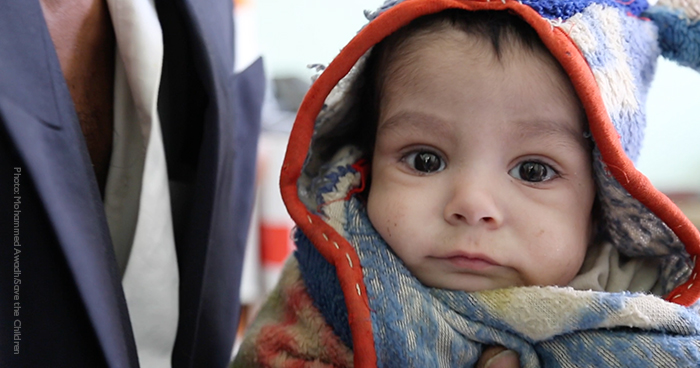
10 month old Qais* receives treatment at Raydah hospital in Amran, northwestern Yemen.
Nearly 1 in 5 children around the world are living in conflict zones, according to a recently-released report from Save the Children.
New findings from the Stop the War on Children report show that 420 million children lived in conflict zones in 2017, an increase of 30 million since 2016. Grave violations against children, including killing, abduction, attacks on schools and denial of humanitarian aid, have tripled since 2010 and numbered more than 25,000 in 2017 – the highest figure ever recorded.
We know that direct violence is extreme and must be addressed, but we often forget that thousands of children die every year from indirect effects of conflict, such as malnutrition, disease and the breakdown of services. For example, in Yemen, Save the Children has estimated that as many as 85,000 children may have died of starvation linked to the conflict.
Both direct and indirect acts of violence have negative consequences on children that are severe and lifelong. The effects can be particularly profound given that the physical, mental and psychosocial development of children is heavily dependent on the conditions they experience.
For example, there is the story of Sajida* who fled persecution and violence in Myanmar with her family: “We suffered a lot while fleeing Myanmar. We were scared when they chased us. They shot a man before our very eyes. It took 10 days to reach Bangladesh. For three days, we didn’t eat. Some people died in the heat. We were so scared.”
Protecting children affected by conflict is Save the Children’s founding mission, and 100 years later, it remains our top priority. We are calling on leaders and governments to:
- Uphold international standards
- Hold perpetrators of violence to account
- Take action to protect children and support their recovery.
In the midst of this enormous challenge, making progress to protect and support children at risk in conflict zones can seem daunting. But we know progress is possible. We have seen it in areas like controlling the use of land mines, where 53 million mines have been destroyed, action to end the recruitment of children into armed groups, where 115,000 children have been released, and measures to keep schools safe in conflict, where 84 countries have endorsed the Safe Schools Declaration.
From Yemen and Syria to Myanmar and South Sudan, the issue is urgent and demands a committed response from those with the influence and power to transform the reality of children in conflict. To turn this tide, governments must take decisive action now. Your voice is needed to demand that our leaders Stop the War on Children.